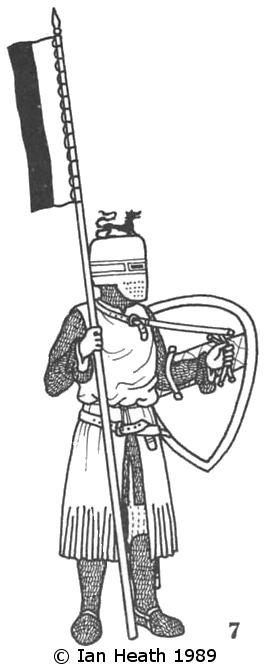|
|
KNIGHT c.1220
An extract from Armies of Feudal Europe 1066-1300
by Ian Heath
 |
7. KNIGHT c.1220
From the German ‘Eneit’ or ‘Eneide’ ms. of Heinrich von Veldeke, dating to c.1210-20, this figure shows little change from
the last, the only real difference being the addition of quilted thigh pieces called cuisses
reaching to below the knee, making their first appearance in this ms. Illustrations in the later ‘Maciejowski Bible’
make it quite clear that these were tubular in construction, pulled up over the leg onto the thigh and probably laced to a waist-belt like the chausses.
The ‘Eneide’ ms. is also interesting for the crests worn by many of its knights, featuring birds, animals, discs, flags etc.
These do not bear any relation to the shield devices or surcoat heraldry of the wearer,
and to judge from other sources this appears to have been not uncommon at this early date.
Helmet crests (the word ‘crest’ derives from Latin crista, meaning a cock’s comb) first appeared in the late-12th century,
the earliest on record apparently being a pair of stag’s antlers attached to the helmet of a Spanish knight at the siege of Tyre in 1187,
while the seal of count Baldwin of Flanders (1197),
depicting a lion-crested helmet virtually identical to that shown here, appears to be the earliest contemporary representation;
the oft-reproduced crest from the second great seal (1198) of King Richard I of England —
see figure 5a in Armies and Enemies of the Crusades — comes a close second (though some authorities date this seal to 1195).
By the end of the 13th century they had become highly ornate, often duplicating the wearer’s heraldic device.
They were probably mostly manufactured from parchment, feathers, wood, leather and fabric,
though William le Breton records that the antlers worn on his helmet by Count Renaud at the Battle of Bouvines were made of carved whalebone.
This ms. also has other minor details worthy of note, such as mail coifs covering the whole face except for eye-holes,
and a sword suspended from a cord round the wrist (other sources describing similar wrist-cords for maces).
The lance was now usually about 10 feet in length.
[Based on Eneit or Aeneasroman by Heinrich von Veldeke]
|
|